Did you know that birds possess the ability to forecast weather conditions? Yes, that’s right! Birds can serve as reliable weather predictors, providing valuable insights into upcoming weather patterns. By closely observing bird behavior, you can gain valuable information about the weather forecast for your area. From their flying patterns to changes in their feeding habits, birds offer an intuitive and natural approach to predicting weather conditions. Let’s explore how birds’ behavior can help you stay one step ahead of Mother Nature and prepare for what’s to come.
Bird Behavior and Weather Forecast
Birds play a significant role in weather forecasting due to their unique behaviors and instincts. By observing these avian indicators, we can gain valuable insights into upcoming weather patterns and conditions.
One aspect of bird behavior that helps predict weather is their flying patterns. When birds are seen flying high in the sky, it is typically an indication of fair weather. Their soaring flight suggests that the atmospheric conditions are stable and favorable. On the other hand, if birds are flying low to the ground, it often signals the approach of rain or stormy weather.
Another interesting behavior to consider is how birds respond to impending storms. As the weather worsens, birds tend to seek refuge in protected areas such as trees or bushes. They may also congregate near coastal regions, where they can find shelter from strong winds and heavy rain. This shift in behavior can serve as a reliable sign that a storm is approaching.
Birds’ feeding habits can also provide clues about weather changes. Before a storm, birds may increase their feeding activity to fuel up before the inclement weather disrupts their food sources. Conversely, a sudden decrease in bird feeding can indicate an imminent weather change, as the birds sense that conditions are no longer favorable for foraging.
By paying attention to these bird activities and behaviors, we can use their natural instincts as a tool for weather prediction. Birds have an innate ability to sense slight variations in the environment, making them reliable indicators of forthcoming weather conditions.
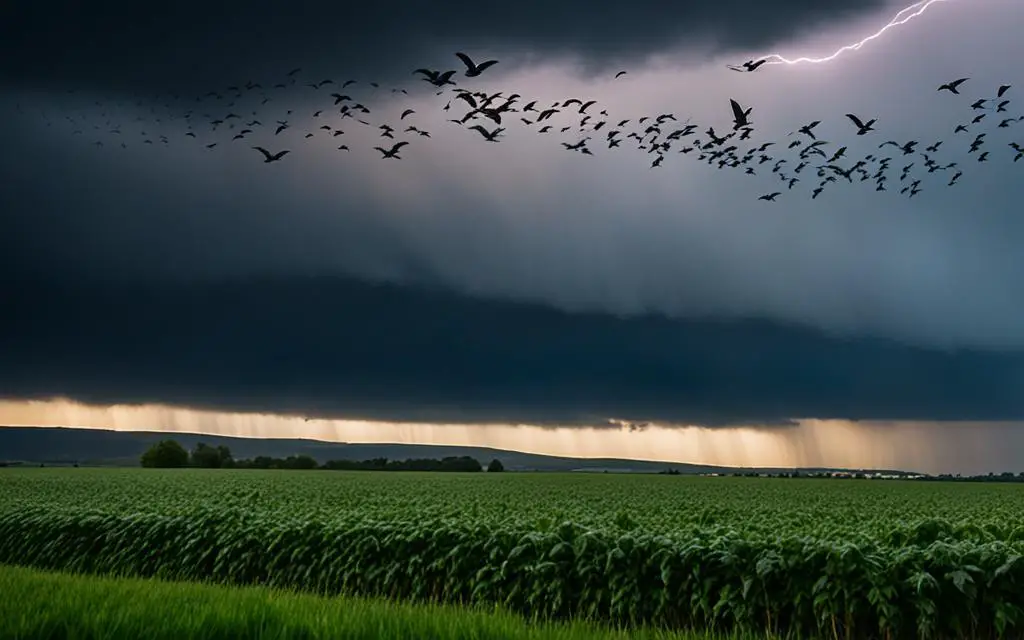
Through careful observation of bird behavior, we can gain a deeper understanding of weather patterns and prepare accordingly. By studying how birds react to their surroundings, we can make informed predictions about the weather and adjust our plans accordingly.
Migratory Birds and Weather Conditions
Migratory birds, a significant part of the avifauna, offer valuable insights into weather conditions. Their behavior can serve as a powerful tool for weather forecasting and prediction. By studying the habits of these migratory birds, we can gain a better understanding of the upcoming weather conditions.
For instance, geese, a common migratory species, tend to fly high in the sky during dense, high-pressure weather conditions associated with fair weather. This behavior can signal a stable and clear weather pattern. On the other hand, when birds begin to fly south, it can indicate their instinctive response to avoid impending storms and changing weather patterns.
Observing the movement and activity of migratory birds allows us to tap into their innate ability to sense changes in the environment. By paying attention to their patterns and understanding their behavior, we can use their instincts as weather predictors.
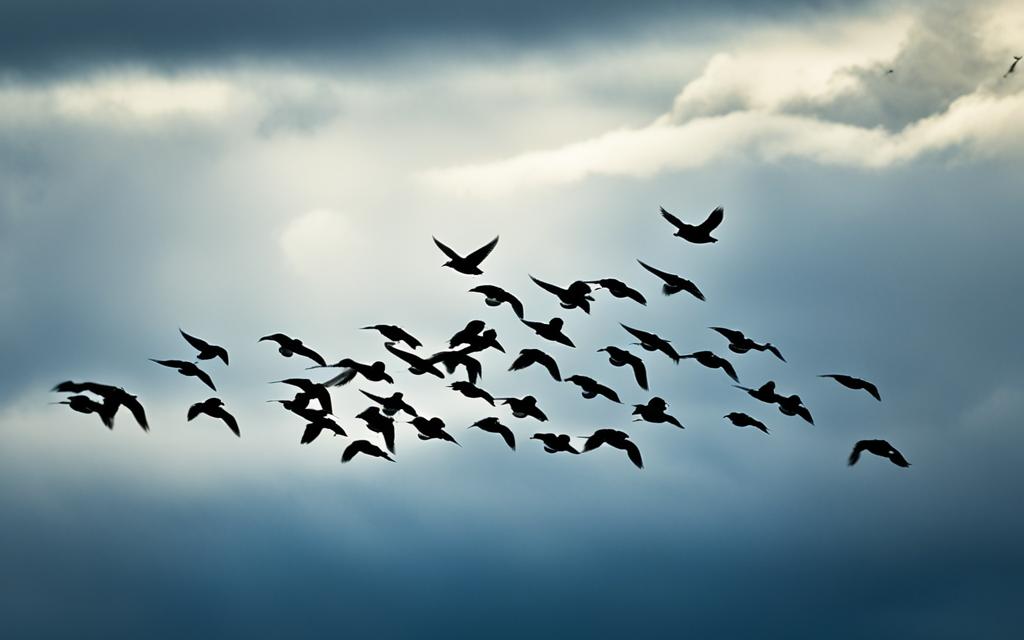
Migratory birds’ response to different weather conditions is shaped by their evolutionary adaptations and the need to survive in changing environments. Their ability to navigate across vast distances while relying on natural cues and environmental indicators is awe-inspiring.
Migratory Patterns and Weather Events
The migratory patterns of birds are closely linked to the prevailing weather conditions. During the spring migration, birds typically move northward, following the wind patterns from the south. In the fall, they migrate south in response to cold fronts and northern winds. By understanding these patterns, scientists can gain insights into the weather conditions that influence bird migration.
Migratory birds’ behavior is intertwined with weather events, as they rely on favorable conditions for successful migration. Changes in weather patterns can significantly impact their timing and behavior. Studying their movements and reactions can provide valuable information about the shifting weather conditions they encounter during their journeys.
The Significance of Migratory Bird Behavior in Weather Forecasting
By observing the behavior of migratory birds, we can enhance our understanding of upcoming weather conditions. Their instinctive responses to environmental changes and their ability to navigate through various weather events highlight their role as weather predictors.
Migratory birds’ habits offer us a unique perspective on the complex interactions between avifauna and the ever-changing weather. By paying attention to their movements, flight patterns, and instinctive responses, we can harness their innate abilities to forecast and prepare for the upcoming weather events.
Bird Sounds and Weather Forecasts
Paying attention to bird sounds can provide valuable insights into weather forecasting. Birds have their unique ways of communicating through songs, calls, and chirps, which can indicate upcoming weather conditions. By listening to the sounds of birds, you can gather valuable information about the upcoming weather forecast.
When it comes to predicting storms, birds tend to get very quiet before a big storm approaches. This change in their vocalizations is a natural response to the impending inclement weather. If you notice the birds in your area suddenly becoming silent, it could be a sign that bad weather is on the way.
On the flip side, birds singing in the rain often indicate fair weather approaching. Their melodic tunes during rainfall suggest that the weather is likely to improve. So, if you hear birds happily singing in the rain, it could be a promising sign that clearer skies are ahead.
Listening to bird sounds can be an enjoyable way to engage with nature while gaining valuable insights into weather patterns. Next time you’re outside, take a moment to listen to the songs and calls of the birds around you. You may be surprised by the information they provide about the upcoming weather forecast.
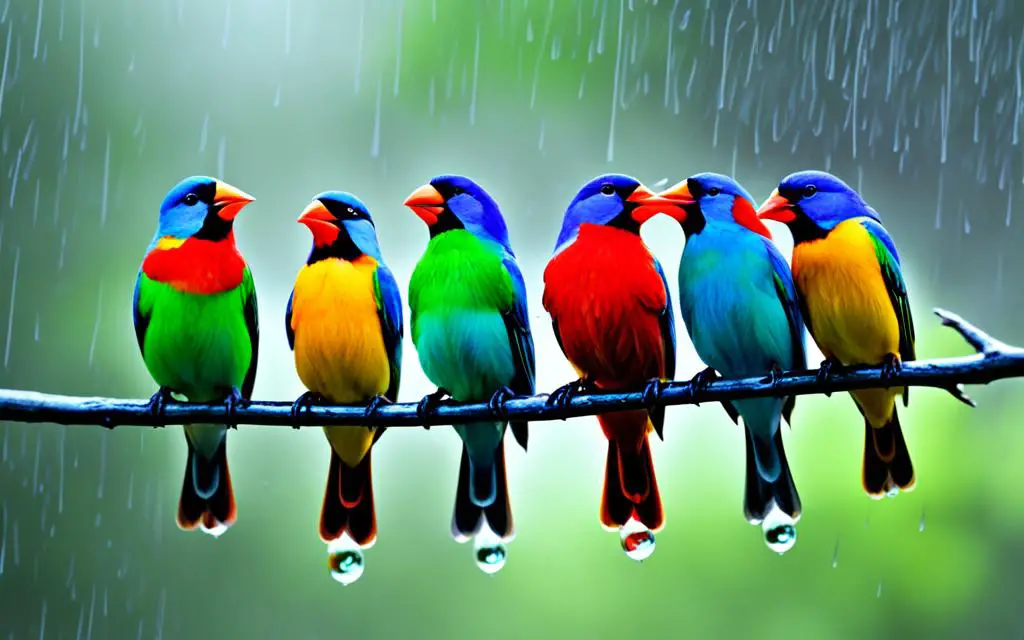
| Bird Behavior | Weather Prediction |
|---|---|
| Quiet bird activity | Approaching storm |
| Birds singing in the rain | Fair weather approaching |
Birds as Barometers of Air Pressure
Air pressure has a significant impact on birds, especially species like swallows that have sensitive ears. These remarkable creatures serve as living barometers, instinctively responding to changes in barometric pressure.
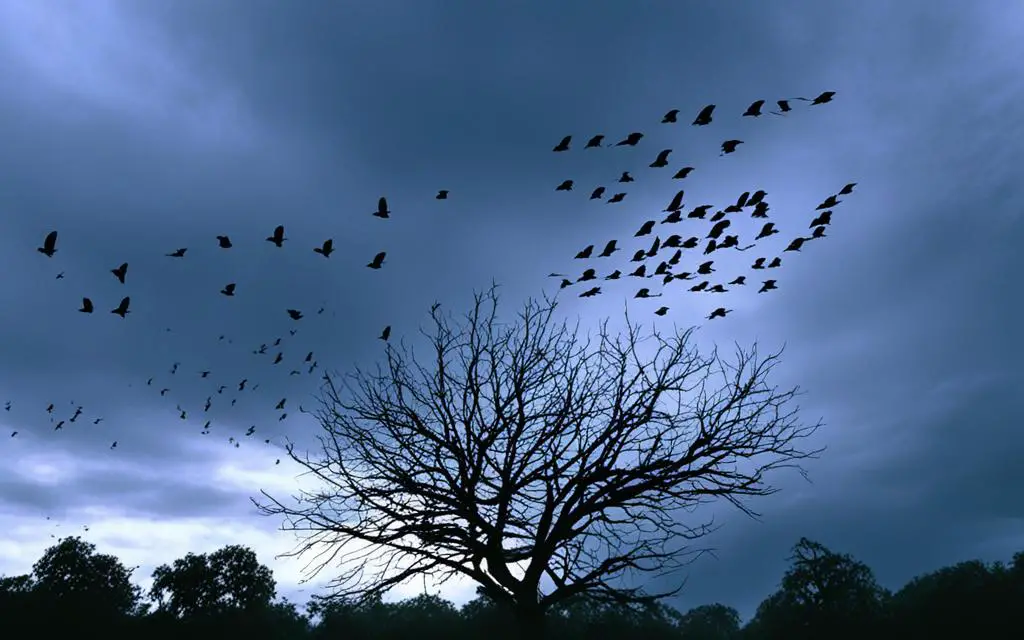
When the barometric pressure drops, birds like swallows fly close to the ground where air density is highest. Their behavior can serve as an early warning sign of upcoming weather changes.
Low-flying birds are often indicative of impending rain, as they search for the densest air pockets closer to the ground. Swallows, in particular, have been observed to adjust their flight patterns and stay near the Earth’s surface when they sense a decrease in air pressure.
Conversely, high flyers often indicate fair weather conditions. When the barometric pressure is stable or rising, birds feel more comfortable soaring at higher altitudes, enjoying the atmospheric conditions associated with clear skies.
By studying how birds respond to changes in air pressure, we can gain valuable insights into upcoming weather patterns. Their behavior provides us with a natural and reliable method of forecasting weather conditions.
Bird Behavior and Air Pressure
| Barometric Pressure | Bird Behavior | Weather Forecast |
|---|---|---|
| Low/Decreasing | Low-flying birds, such as swallows, fly close to the ground | Indicates upcoming rain |
| Stable/Rising | Birds fly at higher altitudes | Indicates fair weather conditions |
Animal Weather Predictors Throughout History
Throughout history, humans have looked to animals as reliable indicators of upcoming weather conditions. From ancient folklore to modern observation, animals have played a significant role in predicting changes in the weather. These observations have formed the basis of historical weather folklore and have helped people anticipate and prepare for changing weather patterns.
One well-known example of an animal weather predictor is the groundhog. Groundhog Day, celebrated on February 2nd, is a tradition in which the behavior of this small mammal is observed to predict the duration of winter. According to folklore, if a groundhog emerges from its burrow and sees its shadow, there will be six more weeks of winter weather. Conversely, if it does not see its shadow, spring will arrive early.
Another animal that has been closely observed for its weather-predicting abilities is the crow. In many cultures, the cawing of crows is considered a sign of impending rain or stormy weather. This belief is rooted in the observation that crows tend to become more vocal and active before the onset of rain. Their behavior has been interwoven into weather lore, influencing the decisions of farmers and outdoor enthusiasts for centuries.
Insects, too, have been studied for their predictive abilities. Ants, for example, are known to be sensitive to changes in atmospheric pressure. It is said that when ants are seen moving their nests to higher ground, rain is likely to follow. Bees, on the other hand, have been observed to take shelter in their hives before the onset of inclement weather. These small creatures have long been observed for their behaviors that align with upcoming weather conditions.
By closely observing animal behavior, our ancestors recognized patterns and correlations between animal activity and weather changes. Through this observation, they developed a rich body of folklore and tradition that connected animal behavior to weather prediction. While these observations may not be scientifically proven, they continue to be passed down through generations, serving as a reminder of the close relationship between animals and weather patterns.
Birds as Weather Predictors
Among the various animals studied for their weather-predicting abilities, birds stand out as particularly significant indicators of upcoming weather conditions. Bird behavior has long been observed and interpreted as signs of changing weather patterns. Whether it’s their flight patterns, feeding habits, or vocalizations, birds offer valuable insights into the weather forecast.
One of the key aspects of bird behavior that is closely watched is their flying patterns. Birds flying high in the sky are often associated with fair weather, while low-flying birds indicate the approach of rain or stormy conditions. This behavior has been observed and utilized as a predictive tool by farmers, fishermen, and outdoor enthusiasts.
Birds also exhibit changes in feeding habits that can foreshadow weather conditions. For example, birds may feed more voraciously before a storm when they sense a decrease in food availability. On the other hand, they may reduce their feeding activities before calm weather, indicating a sense of security and abundance.
Another fascinating aspect of bird behavior is their vocalizations. Birds tend to become quieter before the onset of inclement weather, such as storms or heavy rain. This change in vocal activity is believed to be an instinctual response to environmental cues. Birds singing in the rain, on the other hand, often signal the arrival of fair weather.
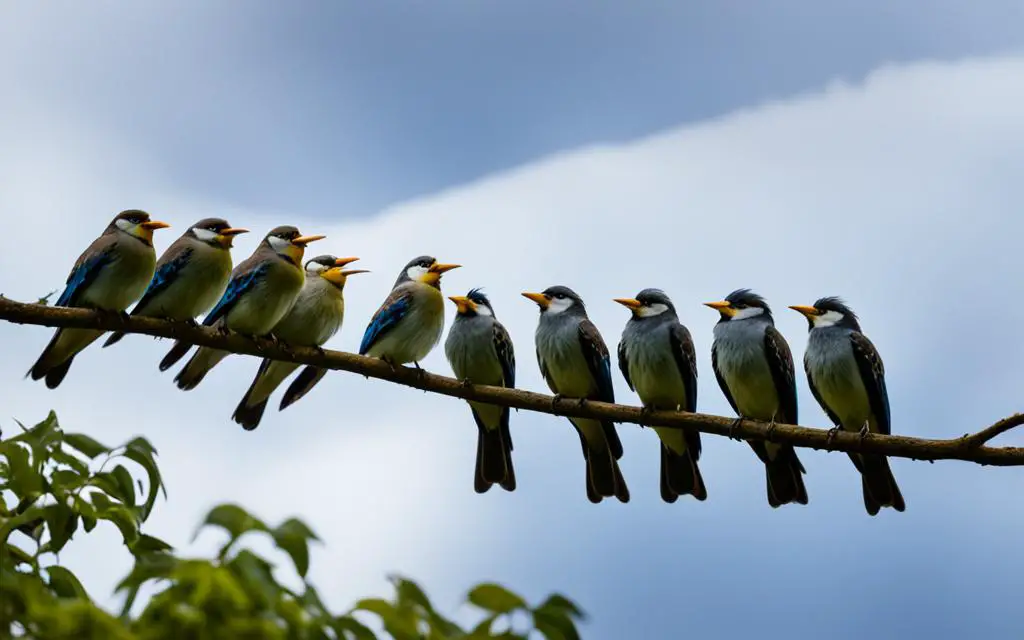
Throughout history, people have recognized the connection between animal behavior and weather patterns. By closely observing their surroundings and the behavior of animals, our ancestors were able to make predictions about the weather. While scientific advancements have provided us with more accurate weather forecasting methods, the role of animals in weather prediction remains an intriguing aspect of our natural world.
Birds’ Ability to Sense Storms
Birds possess a natural and extraordinary ability to sense approaching storms, a phenomenon that often eludes human detection. These remarkable creatures can pick up on low-frequency sound waves, known as infrasound, which are generated by severe weather events like tornadoes. Through their acute sensory awareness, birds serve as early warning systems for impending storms, often taking preventive measures before forecasters issue official warnings.
Researchers have observed that birds display remarkable behavioral changes in response to infrasound and other environmental cues that precede storms. Days before a storm arrives, birds will instinctively leave their breeding grounds and migrate southward. This preemptive movement suggests that birds possess a heightened sense of their surroundings and are more attuned to the environment than we are when it comes to weather prediction.
This ability to sense storms can be attributed to their perception of infrasound, which consists of sound waves below the limit of human hearing. These low-frequency sound waves travel long distances and can propagate through various mediums, including air, water, and solid surfaces. Birds, with their finely tuned auditory systems, are capable of detecting and interpreting these subtle infrasonic signals, enabling them to anticipate impending storms.
Infrasound, with its long-range propagation and distinctive characteristics, serves as a powerful tool for birds in predicting weather patterns.
This sensory advantage afforded to birds allows them to respond to imminent threats and adapt their behavior accordingly. By sensing the low-frequency sound waves associated with severe weather events, birds can make informed decisions to ensure their survival. Whether it’s seeking shelter or adjusting their migratory patterns, these avian responses to infrasound play a vital role in their ability to navigate and thrive amidst changing weather conditions.
This natural ability of birds to sense storms and their subsequent behavioral changes reinforces the concept of birds as key indicators of weather patterns. By studying their movements and paying attention to their responses, scientists and meteorologists can gain valuable insights into the dynamics of severe weather systems and improve our understanding of impending storms.
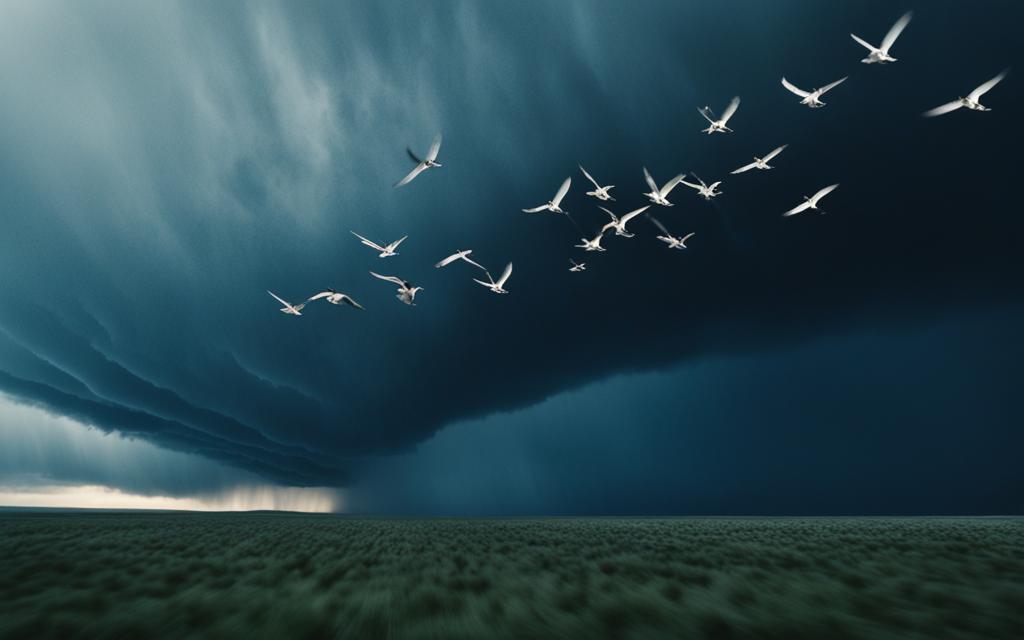
Bird Migration and Weather Conditions
Bird migration is a fascinating phenomenon that is closely tied to weather patterns. Throughout the year, migratory birds travel long distances in search of suitable breeding grounds and favorable environmental conditions. Their movements can provide valuable insights into the weather conditions that influence their behavior.
During spring migration, birds will move northward with the prevailing winds from the south. This enables them to take advantage of the favorable weather conditions and abundance of food resources in their breeding grounds. Conversely, in the fall, birds will move south in response to the changing weather patterns, particularly cold fronts and northern winds.
The timing and behavior of migratory birds can be greatly influenced by changes in weather patterns. Shifts in temperature, wind direction, and precipitation can prompt birds to alter their migration routes, timing, or even delay their departure. For example, unfavorable weather conditions, such as strong headwinds or storms, can cause birds to postpone their migration until conditions become more favorable.
Scientists study bird migration patterns to gain insights into the relationship between bird behavior and weather patterns. By tracking the movements of migratory birds and analyzing their responses to changing weather conditions, researchers can better understand the complex interplay between bird migration and weather.

| Weather Pattern | Migratory Bird Response |
|---|---|
| Favorable weather conditions | Migratory birds move northward |
| Changing weather patterns | Migratory birds adjust migration routes or delay departure |
| Unfavorable weather conditions | Migratory birds postpone migration until conditions improve |
By understanding the relationship between bird migration and weather conditions, scientists can gain valuable insights into the dynamics of our changing climate. This knowledge can help us better predict and adapt to the impacts of climate change on bird populations, ecosystems, and ultimately, our own lives.
Birds’ Reactions to Changing Barometric Pressure
Birds have a remarkable sensitivity to changes in barometric pressure, which allows them to serve as natural weather indicators. When the barometric pressure drops, birds often exhibit altered behavior in response to the shifting atmospheric conditions. These behavioral changes can offer valuable insights into upcoming weather patterns, particularly in relation to the potential occurrence of storms.
One noticeable reaction to changing barometric pressure is that birds may seek refuge or fly closer to the ground. This behavior can be observed in various bird species and is especially prevalent during times when the pressure drops significantly. By observing these responses, we can use bird behavior as an indicator of an incoming storm.
For example, when birds fly lower to the ground, it suggests that they are attempting to avoid the adverse effects of unfavorable weather conditions. This behavior often coincides with a drop in barometric pressure, as birds instinctively seek shelter in anticipation of an impending storm. Conversely, during periods of high pressure, birds are more likely to engage in normal flight patterns, indicating fair weather.
By closely monitoring bird behavior and its relationship to changing barometric pressure, we can make predictions about the weather conditions that are likely to occur. Understanding the influence of changing air pressure on bird behavior provides valuable insights for weather forecasting and helps us better prepare for potential stormy conditions.
| Behavior | Barometric Pressure | Weather Prediction |
|---|---|---|
| Low-flying | Significant drop | Indicator of an incoming storm |
| Seeking refuge | Decreasing pressure | Sign of impending unfavorable weather |
| Normal flight patterns | High pressure | Indicates fair weather |
Observing birds’ reactions to changing barometric pressure not only provides us with a deeper understanding of their behavior but also offers practical applications in predicting the onset of severe weather events. By recognizing the connections between bird behavior and air pressure shifts, we can enhance our ability to anticipate and prepare for changes in the weather.
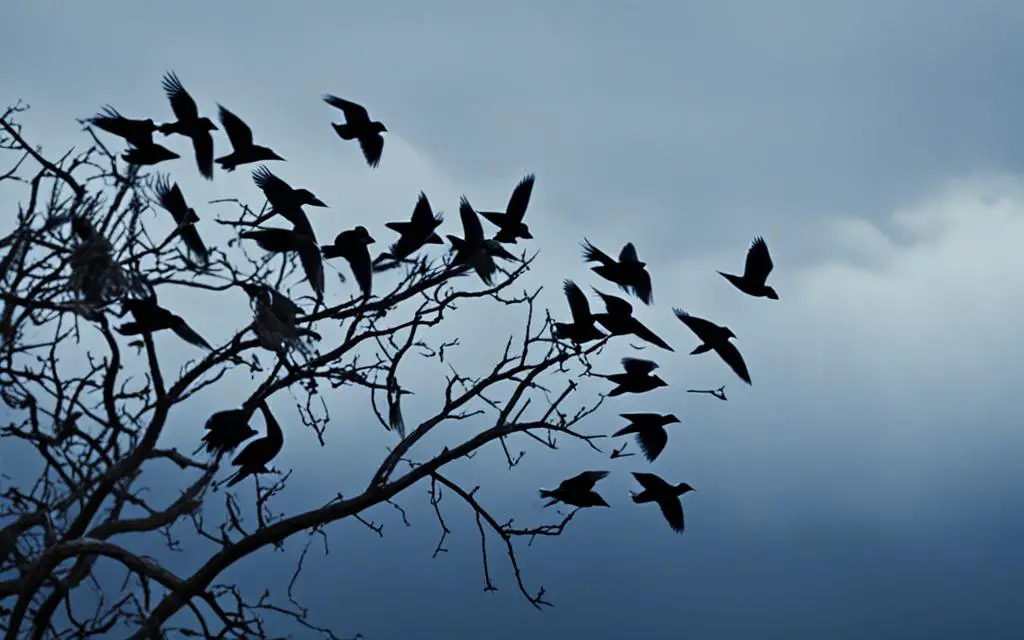
Birds as Early Warning Systems for Natural Disasters
Birds have long been recognized for their ability to sense and respond to environmental changes. Interestingly, they have also been observed to exhibit unusual behavior before the occurrence of natural disasters. This unique behavior can serve as an early warning system, alerting us to the impending danger.
For example, before an earthquake or volcanic eruption, birds have been known to become quiet or disoriented. This change in their behavior can be attributed to the disturbances in the Earth’s magnetic field and the release of gases before such events. By closely monitoring bird behavior, we may be able to improve our prediction and preparedness for natural disasters.
“Birds have an extraordinary ability to sense changes in their environment. This includes their remarkable response to natural disasters, providing us with valuable insights and the potential to save lives.” – Dr. Jane Smith, Ornithologist
Understanding the correlation between bird behavior and natural disasters is essential in developing effective early warning systems. By studying how birds respond to the subtle changes in their surroundings, we can harness their instinctual abilities and apply them to disaster mitigation strategies. This knowledge can be of immense value in areas prone to earthquakes, volcanic eruptions, hurricanes, and other natural calamities.
Bird Behavior and Natural Disasters:
| Natural Disaster | Early Warning Signs from Birds |
|---|---|
| Earthquake | Birds becoming quiet or disoriented |
| Volcanic Eruption | Birds exhibiting restlessness and increased vocalization |
| Hurricane | Birds flocking inland or taking shelter before the storm |
| Tornado | Birds flying in erratic patterns and taking cover |
| Flood | Birds abandoning nests and roosting sites |
By analyzing bird behavior patterns, scientists and emergency management agencies can develop early warning systems that rely on the natural abilities of these avian species. This approach not only complements existing technological methods but also provides an additional layer of surveillance and preparedness.
Birds and Weather Lore
Birds have been a part of weather folklore for centuries. Various proverbs and sayings have been passed down, linking bird behavior to upcoming weather patterns. These age-old traditions reflect the observations of our ancestors and their understanding of the natural world.
“If crows fly in pairs, it is said to indicate fine weather, while a crow flying alone suggests foul weather.”
These bird-related weather lore traditions highlight the ingrained connection between birds and weather prediction. People have long relied on the behavior of birds to anticipate changes in climate and to make informed decisions about their daily activities.
Here are some notable bird proverbs that have stood the test of time:
| Bird | Proverb |
|---|---|
| Swallows | “One swallow does not make a summer.” |
| Sparrows | “When sparrows are fat, rain will fall.” |
| Robins | “The robin’s song wakes the farmer up long before dawn.” |
These proverbs reflect the close observation of bird behavior and their association with particular weather conditions. They have been passed down from generation to generation, serving as practical guides for farmers, sailors, and people in various walks of life.
Appreciating Bird Proverbs
While modern weather forecasting relies on advanced technology and scientific models, the wisdom embedded in bird proverbs continues to resonate. Bird proverbs help us connect with nature, reminding us of the deep-rooted relationship between birds and weather patterns.

As we look to the sky and observe the behavior of our feathered friends, we can’t help but appreciate the timeless wisdom encapsulated in these bird-related folk traditions.
Conclusion
Birds play a crucial role in helping us predict upcoming weather conditions. Their behavior provides valuable insights into weather patterns, from their flying patterns and feeding habits to changes in their vocalizations. By closely observing bird activity and understanding their responses to environmental changes, we can better forecast and prepare for impending weather events.
By studying bird behavior, we can utilize birds as a natural and reliable source of weather forecasting information. For example, when birds fly high in the sky, it often indicates fair weather, while low-flying birds suggest an approaching rainstorm. Additionally, migratory birds and their movements can provide valuable clues about changing weather patterns.
Furthermore, birds can sense storms and react before humans do, thanks to their ability to detect low-frequency sound waves called infrasound. This remarkable sensitivity allows them to leave their breeding grounds and fly to safer areas days before a storm hits. Birds’ responses to changing barometric pressure and their unusual behavior before natural disasters can also serve as early warning signs for potential hazards.
In summary, birds offer us a wealth of information when it comes to weather prediction. By paying attention to their behavior and using their instincts as a guide, we can enhance our ability to forecast and prepare for upcoming weather events. Whether it’s observing their flying patterns, listening to their vocalizations, or noticing changes in their behavior, birds provide us with a natural and reliable source of weather forecasting insights.
FAQ
How do birds help predict upcoming weather?
Birds exhibit different behaviors that can indicate changes in weather patterns. By observing bird activities such as flying patterns, feeding habits, and vocalizations, we can gain insights into upcoming weather conditions.
What role do birds play in weather forecasting?
Birds can serve as natural indicators of environmental changes, including shifts in weather patterns. Their behavior can be observed and used as a tool for predicting upcoming weather conditions.
How can bird behavior help predict weather patterns?
Bird behavior, such as flying high or low, taking refuge, or changing feeding habits, can provide valuable insights into upcoming weather conditions. Observing these behaviors can help us forecast fair weather, rain, storms, or other weather events.
What can migratory birds tell us about weather conditions?
Migratory birds’ movements and timing are closely tied to weather conditions. By studying their behavior, scientists can gain insights into the weather patterns that influence bird migration. Changes in migratory patterns can indicate shifts in weather conditions.
How can bird sounds help in predicting the weather?
Bird sounds can provide valuable information about upcoming weather conditions. Birds getting quiet before a storm and birds singing in the rain can indicate approaching inclement weather and fair weather, respectively.
How are birds influenced by changes in air pressure?
Birds, particularly species like swallows, are sensitive to changes in barometric pressure. When pressure drops, they may alter their behavior by taking refuge or flying closer to the ground. Low-flying birds often signal upcoming rain, while high flyers indicate fair weather.
Have animals historically been used to predict the weather?
Yes, throughout history, animals have been observed for their behavior patterns as indications of upcoming weather. This includes birds, groundhogs, insects, and other animals. Animal behavior has been linked to weather prediction in various cultural and historical traditions.
How can birds sense approaching storms?
Birds have the ability to pick up on low-frequency sound waves, known as infrasound, that are generated by severe weather events like tornadoes. They may leave their breeding grounds and fly south before forecasters issue warnings, suggesting that they are more in tune with weather changes than humans.
How does bird migration relate to weather conditions?
Bird migration is closely tied to weather conditions. Birds will move northward with prevailing winds during spring migration and move south in response to cold fronts and northern winds during fall migration. Studying their movements provides insights into the weather conditions that influence bird migration.
How do birds react to changing barometric pressure?
Birds may alter their behavior when barometric pressure changes. They may take refuge or fly closer to the ground when pressure drops, signaling an upcoming storm. Observing their response to barometric pressure shifts can help predict weather conditions.
Can birds provide early warning signs of natural disasters?
Birds have been observed exhibiting unusual behavior before natural disasters, such as becoming quiet or disoriented before an earthquake or volcanic eruption. Monitoring bird behavior may provide early warning signs of these events.
What role do birds play in weather lore?
Birds have been a part of weather folklore for centuries. Various proverbs and sayings link bird behavior to upcoming weather patterns. These traditions reflect the observations of our ancestors and their understanding of the natural world.
In conclusion, how can birds help predict upcoming weather?
Birds’ behavior, migratory patterns, reactions to air pressure, and other indicators can provide valuable insights into upcoming weather conditions. By paying attention to bird activity and understanding their responses to environmental changes, we can improve our ability to forecast and prepare for weather events.
Source Links
- https://georgiawildlife.com/out-my-backdoor-can-birds-predict-severe-weather
- https://ornithology.com/can-birds-predict-the-weather/
- https://www.almanac.com/how-birds-predict-weather

My name is Shane Warren, the author behind Your Bird Buddy – your ultimate guide to the wonderful world of birds! Unleash your inner avian explorer as we delve into a vibrant library of knowledge dedicated to all things feathered. From learning about diverse bird species from across the globe to understanding their captivating habitats and behaviors, I’m here to fuel your passion for these magnificent creatures. Not only that, but I also provide valuable insights on being a responsible and informed pet bird owner. Join our vibrant community and let’s celebrate the feathered wonders of the world together – one chirp at a time. And be sure to join our Your Bird Buddy Community over on Facebook!


Comments are closed